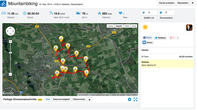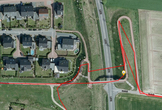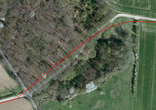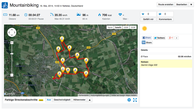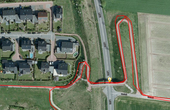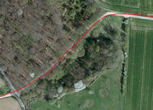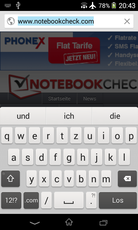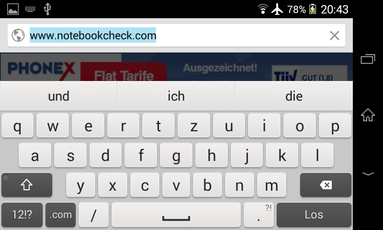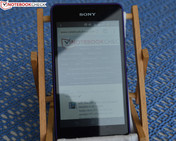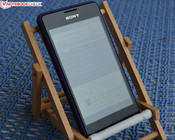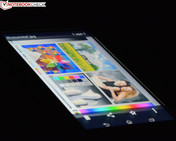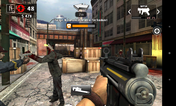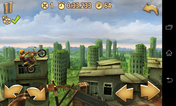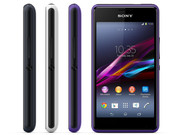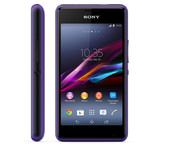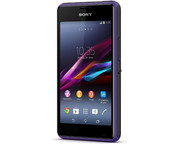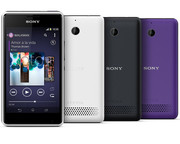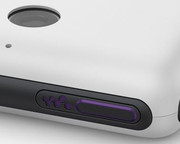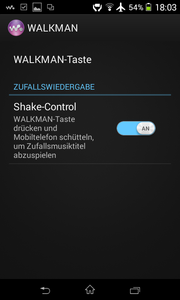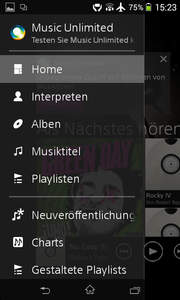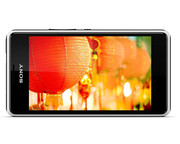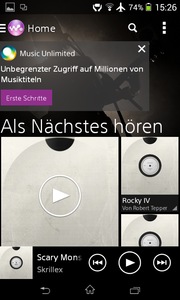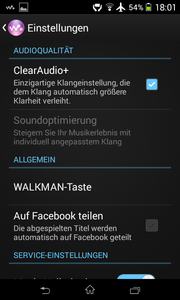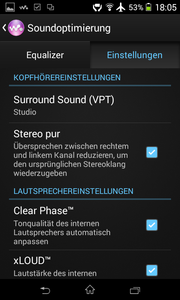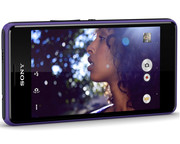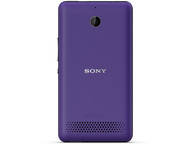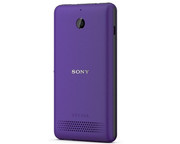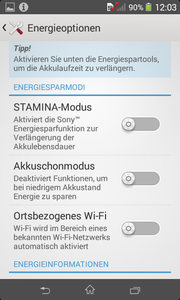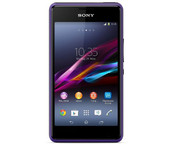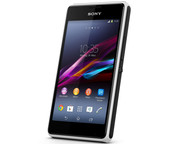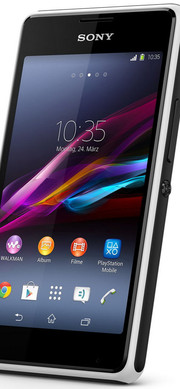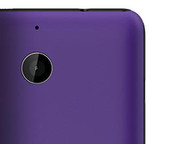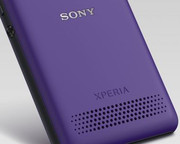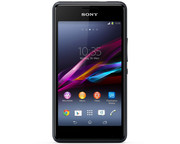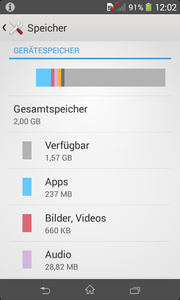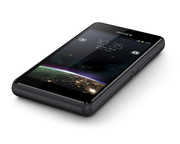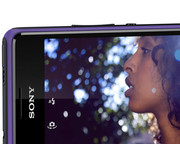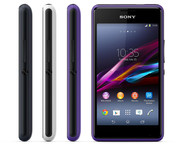Sony Xperia E1 Smartphone Review
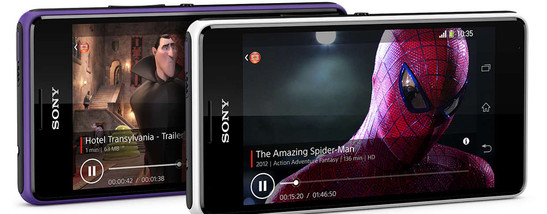
For the original German review, see here.
Sony continues its affordable entry-level Xperia E smartphone line and launches the 4-inch Xperia E1. Its focus is on the low price of 129 Euros (~$174, RRP), and the music player feature with a dedicated Walkman hardware button that enables directly accessing saved media via a Walkman app. Sony also specifies an awesome maximum volume of 100 dB for the speaker installed on the back, which excels with ClearAudio+ and the xLoud audio enhancer.
The flashy plastic casing sports a basic Qualcomm Snapdragon 200 MSM8210 dual-core SoC with a clock rate of 1.2 GHz and integrated Adreno 302 graphics card, which is supported by 512 MB of working memory. The scanty 4 GB of internal storage can be expanded by up to 64 GB. The 4-inch screen has a resolution of 480x800 pixels, and the removable battery offers a whole 6.3 Wh.
Sony's Xperia E1 is available in black, white, and purple like our review sample. The traditional Japanese manufacturer also offers a dual-SIM model for about 10 Euros (~$13) more dubbed Xperia E1 Dual.
It thus competes against contenders like Acer's Liquid Z3 Duo, Huawei's Ascend Y530, Motorola's Moto E, and Nokia's X from the same price range.
Case
It is logical that Sony has to make cutbacks in view of the low price. Fortunately, not in the build; the pressure resistance - at least concerning the casing - and the even gaps are good. Although mineral glass protects the screen, it yields under the slightest pressure, which produces evident discolorations. However, snapping or creaking noises were barely perceptible in the stiffness test. The design is appealing enough, but the polycarbonate casing makes a cheap impression. Neither its looks nor its feel are completely convincing.
The dimensions of 118 x 62.4 mm and weight of 119 grams are alright in the category comparison. However, the thickness of 12 mm is quite high and is almost on par with the slightly oversized Motorola Moto E. The fact that the 1700 mAh battery under the removable back can be replaced makes up for that.
Connectivity
Naturally, a recommended price of 129 Euros (~$174) also has an impact on connectivity. Nevertheless, the bundle makes a balanced and entry-level suitable impression. Sony's Xperia E1 is powered by a fairly new Qualcomm Snapdragon 200 MSM8210 dual-core SoC that clocks with 1.2 GHz. An Adreno 320 graphics chip, a model from the lower entry-level, calculates graphics tasks. The working memory of just 512 MB and the 4 GB internal storage are also tight. The latter's capacity drops to a low 2 GB net but can be expanded by up to 64 GB via a micro-SD card. Unfortunately, it is not possible to move apps to the external SD card, and only media files or documents can be stored there. The physical Walkman button on the smartphone's upper edge that enables direct access to the Walkman app has to be mentioned as a special feature.
Software
Though not one of the latest Android 4.4 KitKat operating systems is installed, Android 4.3 Jelly Bean is used. Among the usual pre-loaded software, the Walkman app that scores with album cover thumbnails and TrackID music recognition is worth mentioning. This enables quickly creating playlists, sharing songs with friends via Facebook, and combining music files. The audio enhancers xLoud and Audio+ featuring Clear Bass, Clear Phase and Clear Stereo, and HD Voice are also available. Interesting for music fans with the matching playback peripherals: The A2DP Bluetooth stereo transmission protocol is also supported. Finally, Sony's Xperia E1 boasts an FM radio with RDS so that the supply of music does not run out on-the-go.
Long pressure on the dedicated Walkman button opens the Walkman app; short pressure controls play/pause. The Shake Control feature allows easy fast-forwarding by simply shaking the smartphone, for example.
Communication & GPS
The installed communication equipment is very solid. Although LTE is not offered in this price range (even if a manufacturer picture of Sony's Xperia E1 suggests the opposite), and dual-band Wi-Fi is not on board either, the review sample has NFC. Quad-band GSM (850/900/1800/1900 MHz) and the higher-speed Tri-band UMTS (850/1900/2100 MHz) including HSPA+ (up to 21 Mbps in downstream, and 5.76 Mbps in upstream) should ensure reception and swift data transfer almost everywhere. Bluetooth 4.0 is also available for short range transmissions. The integrated Wi-Fi b/g/n offers tethering (hot-spot feature) in addition to good signal strength.
The review sample also sports an A-GPS/GLONASS module. The GPS Test app certified good localization. However, it displayed minor inaccuracies during real-life conditions on an approximately 11-kilometer cycle route compared with the Garmin Edge 500 navigation system. The ascertained total route was roughly 200 meters too short; tracking particularly deviated from the real distance traveled in curves. Nevertheless, it is quite possible to use it for occasional navigation purposes.
Telephony and Speech Quality
The phone app does not conceal any surprises and is clearly arranged. The manufacturer only made little modifications in looks. Large keys allow accurate typing.
The speech and audio quality in calls is convincing. The installed noise cancellation and voice optimization do their job, and they produce a quite natural sound. Owing to the loud speaker, Sony's Xperia E1 is also compelling in hands-free mode.
Cameras and Multimedia
On paper, the rear-facing camera unit sounds impressive with a resolution of 3 megapixels, HDR, four-time zoom, and an HD video recording feature. However, not much of that is left in practical use. Unfortunately, the camera struggles with slight noise, overexposure with bright objects, and it cannot capture enough light in dark surroundings. An LED flash is not installed, and dark picture areas consequently quickly lose details. A lack of sharpness is also noticed.
A front-facing camera for video chats or popular selfies is not installed from the outset.
Accessories
Besides Sony's Xperia E1 phone, the box includes the battery, a modular charger including a micro-USB cord, and a stereo headset. Sony optionally offers many accessories, such as the BM10 Bluetooth music receiver for about 60 Euros (~$81) or even the SBH80 Bluetooth luxury headset for approximately 100 Euros (~$135).
Warranty
Sony includes a 24-month warranty on the phone; the battery and headset are only protected for 6 months.
Input Devices and Controls
The keyboard is comfortable to use and corresponds to the stock Android model. The keys are much bigger in landscape mode, but the visible screen shrinks to a narrow stripe. Key tones and vibrations increase the feedback optionally.
The capacitive touchscreen functions satisfactorily up to its edges. Its gliding properties are very good, but occasional, short lags between input and implementation occur. The smartphone could also sometimes stagger for a moment when inputs are made very quickly.
Display
The screen in Sony's Xperia E1 has a size of 4-inches with a sufficiently high resolution of 800x400 pixels. The sensitive TFT screen is additionally protected by scratch-resistant mineral glass.
Its brightness of approximately 358 cd/m² is also relatively high. Although the review sample surpasses Acer's Liquid Z3 Duo in a direct comparison with the contenders, it cannot compete with Huawei's Ascend Y530, Motorola's Moto E or Nokia's X. However, the very homogeneous illumination of 92% is on par with Nokia's X, and slightly surpasses both Acer's Liquid Z3 Duo and Huawei's Ascend Y530. It does not quite reach the 96% of Motorola's Moto E.
| |||||||||||||||||||||||||
Brightness Distribution: 92 %
Center on Battery: 348 cd/m²
Contrast: 682:1 (Black: 0.51 cd/m²)
ΔE ColorChecker Calman: 6.43 | ∀{0.5-29.43 Ø4.79}
ΔE Greyscale Calman: 7.92 | ∀{0.09-98 Ø5}
Gamma: 2.52
CCT: 9560 K
Both the black level of 0.51 cd/m² and contrast of 682:1 are almost on par with Motorola's Moto E in the category comparison but do not quite reach the marginally better rates of Acer's Liquid Z3 Duo. Then again, Sony's Xperia E1 has a clear lead on both Huawei's Ascend Y530 and Nokia's X.
The subjective assessment in routine use is appealing owing to a decent black in dark picture or video sequences, and good image sharpness.
The analysis using the X-Rite i1pro2 colorimeter and CalMAN software shows a too high color temperature of 9560 K (ideal approx. 6500 K). Particularly the reproduction of red hues is extremely shifted, and blue hues are clearly overemphasized. The average DeltaE of 6.43 is still within limits, but a slight gray-yellowish cast is noticed.
The DeltaE of 7.92 in the grayscale is clearly too high. A visible, bluish discoloration is seen in the grayscale reproduction. These color shifts are already seen in dark gray colors. Subjectively, the measured deficiencies are considerably less serious than presumed though.
Although the screen in Sony's Xperia E1 is quite suitable for outdoor use with its maximum of 377 cd/m², the intensely reflective mineral-glass surface sometimes clearly limits the legibility. Thus, avoiding direct light makes outdoor use feasible.
The screen's viewing-angle stability in practical use is impressively high for a TFT screen - as long as the user does not look down from the screen's upper edge. This perspective quite soon leads to massive color inverting. Otherwise, brightness losses first occur in extreme viewing angles.
Performance
Sony's Xperia E1 is powered by Qualcomm's Snapdragon 200 MSM8210 dual-core SoC processor. This relatively new chip operates with two ARM Cortex A7 cores that clock with 1.2 GHz. Like the SoC itself, the integrated Adreno 302 graphics chip stands for solid performance in the undemanding entry-level sector.
Our benchmark tests nevertheless certify that this combo's performance is good in comparison with the mentioned contending smartphones. Sony's Xperia E1 has the lead on all contenders in virtually all benchmarks, with exception of Motorola's Moto E. Huawei's Ascend Y530 usually follows closely in most benchmarks. Only the storage-related benchmarks sooner show mixed results for the review sample. For example, the Xperia E1 clearly lags behind in the Disk Test of PassMark Performance Test Mobile V1 and has to let the contenders pass by. Phones like Nokia's X or Acer's Liquid Z3 Duo achieve an up to 70% higher score. However, AndroBench 3 is more in favor of Sony's Xperia E1.
| AnTuTu v4 - Total Score (sort by value) | |
| Sony Xperia E1 | |
| Nokia X | |
| Motorola Moto E 1. Gen 2014 | |
| Huawei Ascend Y530 | |
| Acer Liquid Z3 Duo | |
| Geekbench 3 | |
| 32 Bit Multi-Core Score (sort by value) | |
| Sony Xperia E1 | |
| Motorola Moto E 1. Gen 2014 | |
| Huawei Ascend Y530 | |
| Acer Liquid Z3 Duo | |
| 32 Bit Single-Core Score (sort by value) | |
| Sony Xperia E1 | |
| Motorola Moto E 1. Gen 2014 | |
| Huawei Ascend Y530 | |
| Acer Liquid Z3 Duo | |
| AndroBench 3-5 | |
| Random Write 4KB (sort by value) | |
| Sony Xperia E1 | |
| Motorola Moto E 1. Gen 2014 | |
| Huawei Ascend Y530 | |
| Acer Liquid Z3 Duo | |
| Random Read 4KB (sort by value) | |
| Sony Xperia E1 | |
| Motorola Moto E 1. Gen 2014 | |
| Huawei Ascend Y530 | |
| Acer Liquid Z3 Duo | |
| Sequential Write 256KB (sort by value) | |
| Sony Xperia E1 | |
| Motorola Moto E 1. Gen 2014 | |
| Huawei Ascend Y530 | |
| Acer Liquid Z3 Duo | |
| Sequential Read 256KB (sort by value) | |
| Sony Xperia E1 | |
| Motorola Moto E 1. Gen 2014 | |
| Huawei Ascend Y530 | |
| Acer Liquid Z3 Duo | |
Sony apparently does not put much trust in the Android browser and does not pre-load it to start with. Instead, the Xperia E1 uses the stronger Google Chrome browser, on which we also performed our browser benchmarks. We found a fluctuating performance here. Both Octane v2 and SunSpider 1.0 always caused errors or even crashed despite several attempts. The benchmarks that ran smoothly place the review sample roughly on par with Motorola's Moto E. Huawei's Ascend Y530 surpasses both devices in Peacekeeper.
These fluctuations were not noticed in routine use; the smartphone did a good job here. Browsing was smooth and in an acceptable speed.
| Mozilla Kraken 1.1 - Total (sort by value) | |
| Sony Xperia E1 | |
| Motorola Moto E 1. Gen 2014 | |
| Huawei Ascend Y530 | |
| Acer Liquid Z3 Duo | |
| Peacekeeper - --- (sort by value) | |
| Sony Xperia E1 | |
| Motorola Moto E 1. Gen 2014 | |
| Huawei Ascend Y530 | |
| Sunspider - 0.9.1 Total Score (sort by value) | |
| Sony Xperia E1 | |
| Nokia X | |
| Motorola Moto E 1. Gen 2014 | |
| Acer Liquid Z3 Duo | |
| WebXPRT 2013 | |
| Offline Notes (sort by value) | |
| Sony Xperia E1 | |
| Acer Liquid Z3 Duo | |
| Stocks Dashboard (sort by value) | |
| Sony Xperia E1 | |
| Acer Liquid Z3 Duo | |
| Face Detection (sort by value) | |
| Sony Xperia E1 | |
| Acer Liquid Z3 Duo | |
| Photo Effects (sort by value) | |
| Sony Xperia E1 | |
| Acer Liquid Z3 Duo | |
| Overall (sort by value) | |
| Sony Xperia E1 | |
| Acer Liquid Z3 Duo | |
* ... smaller is better
| Epic Citadel | |
| Ultra High Quality (sort by value) | |
| Sony Xperia E1 | |
| Motorola Moto E 1. Gen 2014 | |
| Huawei Ascend Y530 | |
| High Quality (sort by value) | |
| Sony Xperia E1 | |
| Motorola Moto E 1. Gen 2014 | |
| Huawei Ascend Y530 | |
| High Performance (sort by value) | |
| Sony Xperia E1 | |
| Motorola Moto E 1. Gen 2014 | |
| Huawei Ascend Y530 | |
Games
The low-range Adreno 302 graphics card shows its deficiencies in the Epic Citadel graphics benchmark. Overall, the contenders manage better here. The practical test reinforces this. The current Angry Birds Go! racing game repeatedly hung up; although the first-person shooter Dead Trigger 2 ran in low details, it sometimes struggled with stuttering and audio drop outs. Nevertheless, the graphics power is enough for many up-to-date games, such as Metal Slug Defense or Trials Frontier.
Emissions
Temperature
Sony's Xperia E1 is pleasantly restrained in terms of surface temperatures. We measured an average idle of 30 to 32 °C on the smartphone's back and front, which is just lukewarm. The temperatures increase to approximately 31 to 34 °C during full load. A maximum of 35.5 °C is reached in single areas. Even the power supply remains within an acceptable range with a maximum of 33.7 °C. The review sample performs well in this sector.
(+) The maximum temperature on the upper side is 35.5 °C / 96 F, compared to the average of 35.2 °C / 95 F, ranging from 21.9 to 247 °C for the class Smartphone.
(+) The bottom heats up to a maximum of 32.8 °C / 91 F, compared to the average of 34 °C / 93 F
(±) In idle usage, the average temperature for the upper side is 32.1 °C / 90 F, compared to the device average of 32.9 °C / 91 F.
Speakers
According to Sony, the rear-sided speaker reaches a volume of up to 100 dB. We cannot confirm this rate, but this much is clear: The smartphone is loud enough. Other problems occur before the volume gets too low. The treble distorts slightly and is always overemphasized, and bass and mids are pushed into the background. It is also evident that the sound output of a current HTC Desire 610, or similar phones, plays in another league.
Energy Management
Power Consumption
Owing to its low-end components, Sony's Xperia E1 is fairly restrained here, and its idle consumption of 0.3 to 1.3 watts is roughly on par with its contenders. It even undercuts all rivals with a full load maximum of 1.5 watts. These rates thus provide the best requirements for a strong runtime performance of the removable 6.3 Wh battery.
| Off / Standby | |
| Idle | |
| Load |
|
Key:
min: | |
Battery Runtime
Sony specifies a capacity of 6.3 Wh/1700 mAh for the Xperia E1's battery, and thus it meets the contenders on equal terms. Only Motorola's Moto E steps out of line with its fat 1980 mAh battery, and it boasts with a runtime of approximately 14 hours in our Wi-Fi test. We perform this test using a screen brightness dimmed to 150 cd/m² and a Wi-Fi script. Sony's Xperia E1 shut down after 8 hours, and Huawei's Ascend Y530 (6.5 Wh/1750 mAh) only lasted 3 minutes longer. Both Acer's Liquid Z3 Duo (5.6 Wh/1500 mAh) and Nokia's X (5.55 Wh/1500 mAh) manage one to two hours more. The review sample shows its strength in full system load using maximum brightness via the Stability Test app with 4:50 hours and outperforms all contenders.
The energy saving mode dubbed "Stamina Mode" considerably extends the battery runtime even more by temporarily disabling unused features.
Verdict
Sony's Xperia E1 has a lot to offer for 129 Euros (~$174, RRP). Being compact and well-built, its looks are more a matter of taste. The choice of materials makes a cheap impression, but not the equipment - of all features, particularly the Walkman function with a dedicated hardware button alongside a powerful music player app. Although the rear-sided speaker achieves a high maximum volume, the sound is rather treble-heavy. The included stereo headset does a better job. The 4-inch screen has a sufficient resolution of 800x480 pixels and is quite convincing considering the price range.
Qualcomm's dual-core SoC is a member of the lower entry-level sector, but its performance is nevertheless absolutely enough for both smartphone newcomers and modest users. They will also be pleased about the removable battery that achieves long battery runtimes. Just as pleasing is the use of the still fairly up-to-date Android 4.3 operating system.
However, a few compromises have to be made as well. For example, the camera's quality is not the best of its kind - although it is a tolerable concession in this price range. The lack of a webcam is also acceptable. But the tight internal storage of approximately 2 GB net is a major drawback. Particularly since although music and other media files can be saved on a micro-SD card, apps cannot be moved to it. Large apps, like some games, thus cannot be installed from the outset.
Would we recommend the review sample? Well, Sony's compact Xperia E1 might in fact be an option for users looking for an affordable, more basic smartphone, who highly value music features but do not feel the urge to install many apps.









